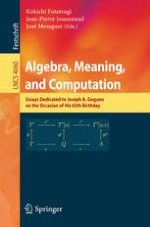Joseph Goguen is one of the most prominent computer scientists worldwide. His numerous research contributions span many topics and have changed the way we think about many concepts. Our views about data types, programming languages, software specification and verification, computational behavior, logics in computer science, semiotics, interface design, multimedia, and consciousness, to mention just some of the areas, have all been enriched in fundamental ways by his ideas.
This Festschrift volume - published to honor Joseph Goguen on his 65th Birthday on June 28, 2006 - includes 32 refereed papers by leading researchers in the different areas spanned by Joseph Goguen's work. The papers address a broad variety of topics from meaning, meta-logic, specification and composition, behavior and formal languages, as well as models, deduction, and computation.
The papers were presented at a Symposium in San Diego, California, USA in June 2006. Both the Festschrift volume and the Symposium allow the articulation of a retrospective and prospective view of a range of related research topics by key members of the research community in computer science and other fields connected with Joseph Goguen's work.
